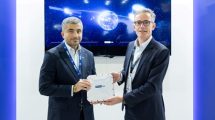
As journalists perfect the perilous task of working in conflict zones, satellite-based technology helps them connect with studios back home with equipment that literally fits into a backpack.
When reporting from conflict zones, anonymity is critical. Portable communications equipment that fit in a backpack has become an essential accessory. Quicklink is one of those solutions providers. Underscoring the dangers they face at times, journalists have occasionally requested managing director, Nabil Ben Soussia’s team at Abu Dhabi-based Safa Telecom, to remove the logo of Quicklink, a well-known video broadcast solution developer and a subsidiary of Safa Telecom, from the backpack. “In conflict zones, the brand could reveal their identity as journalists, and that could, in some cases, be life-threatening,” says Nabil indicating the backpack that essentially equips a journalist on the move with the necessary hardware and software to file reports straight to his studio in Doha, London or New York.
Speaking to SatellitePro Middle East, Nabil was understandably circumspect about mentioning names as journalists using their equipment were probably in conflict zones across the Middle East. In addition to the absence of clear front lines and the basic threat to life, journalists are faced with tenuous cellphone and internet connections.
Nabil explains, “Journalists in conflict zones cannot use 3G without the risk of the link being disconnected or worse, being detected. The Thuraya IP or BGan used with the Quicklink solution, for instance, offers guaranteed data rates of up to 384 kbps for live video and audio broadcast, store and forward audio and video streaming, plus an instant broadband mobile office for email, internet and so on. Used alongside the portable Thuraya IP terminal or the Inmarsat BGan terminal, this solution includes a Quicklink software or hardware encoder with a Quicklink play-out server in the broadcasting studio.”
Affordable, user-friendly satellite equipment
Sending journalists out to report in conflict zones is not a new concept. But what has changed is the availability of user-friendly satellite equipment that is also affordable. When reporting from Iraq in 2009, UK-based journalist Keith Harrison reportedly rented an Iridium satellite phone to use alongside his RBGAN satellite modem and Apple G3 laptop computer in the Gulf as part of his standard equipment. With the Iridium network of 66 satellites, the journalist was free to connect with his UK-based office without having to rely on the Iraqi telephone networks that could become a military target.
For journalists on the move, advancements in the areas of consumer video and IP products combined with mobile satellite technology, are groundbreaking. Leading television networks such as CNN, BBC and Al Jazeera, among others, equip their journalists with portable kits that let them report, edit and produce news packages or go live from nearly anywhere.
With a Mac laptop and an internet connection (BGAN, Thuraya IP and so on) journalists can go live and file reports from almost anywhere in the world. The equipment is extremely small, lightweight and can run off car, truck or camera batteries as well as AC. Indicating the innocuous backpack by his side, Nabil says, “With a BGAN mobile terminal, for instance, reporters can deliver streaming news and as you can see, packaged in this small backpack is a video encoder equipment and battery power.”
Portable encoders from companies such as Quicklink and others, encode video footage and broadcast it to the studio in real time, providing high video quality at low data rates.
Training and trouble-shooting
Giving an indication of the growing demand for these services among the media fraternity, Nabil reveals that the team developing Quicklink in the UK that numbered 10 last year has doubled to 20 this year. However it is easy to get excited about the size and portability of the current satellite-based equipment and overlook the effort Nabil’s team puts into getting journalists up to speed with the equipment, and trouble-shooting when they are reporting from the field.
Nabil says, “I always insist on meeting with the end-user. With TV channels, it is the cameraman who would be in charge of the backpack.” An unusual induction process helped
Nabil understand the stress a journalist on the field would face. During the beta tests of the product, Nabil decided to take the backpack and go offshore to a remote site in a bid to understand the mindset of a field reporter.
Security for journalists
“Never travel without a wire coathanger,” was the advice journalists got in the past. Apparently the coathanger would come in handy to brush away top soil and expose landmines. As more journalists die in conflict zones, security has become a prime concern for news agencies and television broadcasters.
Nabil says, “While the GPS on a typical MSS-based equipment is a one-way method of tracking, the Iridium Shout Nano, for instance, is a handheld, global, two-way satellite messaging and personal tracking device. The Nano is designed with low power consumption electronics and with an internal 1.95 A-Hr rechargeable Li-Ion battery. It can send a position report every hour for up to two months (about 1,500 reports). What is more, the device can periodically wake up from sleep to send its position report to a command centre.
Also if the reporter is in trouble, he just has to use a guarded 911 button that will immediately send alert notifications to the head office.” Having forged partnerships with companies such as Inmarsat, Iridium and Thuraya, among others, Nabil’s team is now intent on working on unique solutions in partnership with Abu Dhabi-based Yahsat once their second satellite Y1B is launched. Elaborating on the customised solutions the company has devised for journalists, Nabil says, “What journalists need is uploading capabilities. Satellite operators and GSM operators design their network towards downloading capabilities. For this reason, we have included in this backpack, no less than six SIM cards and not more than two from the same network , so that the journalist is guaranteed the best of the available connections.
“Another issue we have worked on is customised billing solutions. Our billing process acts as a bridge between the head of news gathering and their finance department. We can present bills missionwise, based on geography and so on. Moreover, there is complete transparency, so that the media house can see usage at the end of a mission.”
Nabil’s optimism about the growth of new digital news gathering systems despite budget cuts and overall recession, is shared by broadcasters. Arnie Christianson, operations manager for CNN’s satellites and transmissions, speaking on this issue has reportedly said: “As belts tighten, news companies will look for less expensive techniques to do their job. This highly mobile gear fits the bill.”
Challenges remain. Broadcasters will want flexible technology that allows them to stream over a variety of low-data rate networks such as Wi-Fi as well as satellite networks like BGAN, Thuraya and VSAT and also be able to switch seamlessly to the least-cost network option available. Secondly, with regard to Thuraya and BGAN-type services, the next hurdle will be to deliver HD quality video from a portable unit in real-time, which requires about a 10- to 20-fold increase in bandwidth performance over products currently available.
Describing the incredible advancements satellite technology has made, Nabil says, “In the past, an organisation had to plug a tape into a machine at some dedicated fibre or satellite uplink location. Now they can use portable laptops and compression to send packaged video over the internet. Given the situation in the conflict zones across the globe, it is much easier to get a laptop and small satellite IP device into remote areas than it is to drive a truck or fly in a dish.”












Add Comment